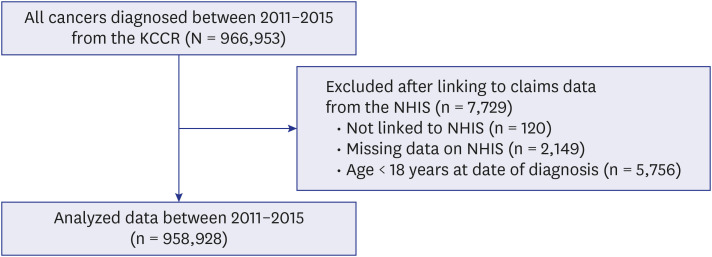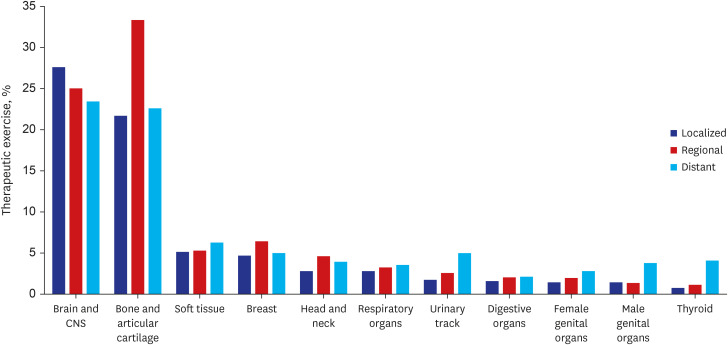J Korean Med Sci.
2021 Nov;36(46):e304. 10.3346/jkms.2021.36.e304.
Underutilisation of Physical Rehabilitation Therapy by Cancer Patients in Korea: a Population-based Study of 958,928 Korean Cancer Patients
- Affiliations
-
- 1National Evidence-based Healthcare Collaborating Agency, Seoul, Korea
- 2Department of Physical Medicine and Rehabilitation, National Cancer Center, Goyang, Korea
- 3Division of Hematology-Oncology, Department of Internal Medicine, National Cancer Center, Goyang, Korea
- 4Division of Hematology and Medical Oncology, Department of Internal Medicine, Seoul National University Bundang Hospital, Seoul National University College of Medicine, Seongnam, Korea
- 5Department of Physical Medicine and Rehabilitation, Seoul National University Bundang Hospital, Seongnam, Korea
- KMID: 2522879
- DOI: http://doi.org/10.3346/jkms.2021.36.e304
Abstract
- Background
Advanced cancers are associated with more severe symptoms and greater impairment. Although most patients with metastatic cancer would benefit from rehabilitation, few patients receive appropriate rehabilitation therapy. We explored the use of rehabilitation therapy by cancer patients. Our data represented the entire population of Korea. The analyses were performed according to cancer type and stage.
Methods
We extracted rehabilitation utilization data of patients newly diagnosed with cancer in the period of 2011–2015 from the Korea Central Cancer Registry, which is linked to the claims database of the National Health Insurance Service (n = 958,928).
Results
The utilisation rate increased during the study period, from 6.0% (11,504) of 192,835 newly diagnosed patients in 2011 to 6.8% (12,455) of 183,084 newly diagnosed patients in 2015. Patients with central nervous system (28.4%) and bone (27.8%) cancer were most likely to undergo physical rehabilitation. The rehabilitation rate was higher in patients with metastatic than localised or regional cancer (8.7% vs. 5.3% vs. 5.5%).
Conclusion
This claims-based study revealed that rehabilitation therapy for cancer patients is underutilised in Korea. Although patients with metastasis underwent more intensive rehabilitation than patients with early stage cancer, those without brain and bone tumours (the treatment of which is covered by insurance) were less likely to use rehabilitation services. Further efforts to improve the use of rehabilitation would improve the outcomes of cancer patients.
Keyword
Figure
Reference
-
1. Gilchrist LS, Galantino ML, Wampler M, Marchese VG, Morris GS, Ness KK. A framework for assessment in oncology rehabilitation. Phys Ther. 2009; 89(3):286–306. PMID: 19147708.
Article2. Javier NS, Montagnini ML. Rehabilitation of the hospice and palliative care patient. J Palliat Med. 2011; 14(5):638–648. PMID: 21592031.
Article3. Young-McCaughan S, Arzola SM. Exercise intervention research for patients with cancer on treatment. Semin Oncol Nurs. 2007; 23(4):264–274. PMID: 18022054.
Article4. Cheville AL, Troxel AB, Basford JR, Kornblith AB. Prevalence and treatment patterns of physical impairments in patients with metastatic breast cancer. J Clin Oncol. 2008; 26(16):2621–2629. PMID: 18509174.
Article5. Silver JK, Baima J, Mayer RS. Impairment-driven cancer rehabilitation: an essential component of quality care and survivorship. CA Cancer J Clin. 2013; 63(5):295–317. PMID: 23856764.
Article6. Gupta AD, Lewis S, Shute R. Patients living with cancer - the role of rehabilitation. Aust Fam Physician. 2010; 39(11):844–846. PMID: 21301657.7. Mewes JC, Steuten LM, Ijzerman MJ, van Harten WH. Effectiveness of multidimensional cancer survivor rehabilitation and cost-effectiveness of cancer rehabilitation in general: a systematic review. Oncologist. 2012; 17(12):1581–1593. PMID: 22982580.
Article8. Yang J, Choi M, Choi J, Kang M, Jo A, Chung SH, et al. Supervised physical rehabilitation in the treatment of patients with advanced cancer: a systematic review and meta-analysis. J Korean Med Sci. 2020; 35(29):e242. PMID: 32715671.
Article9. Thorsen L, Gjerset GM, Loge JH, Kiserud CE, Skovlund E, Fløtten T, et al. Cancer patients' needs for rehabilitation services. Acta Oncol. 2011; 50(2):212–222. PMID: 21231783.
Article10. Park YH, Ko RE, Kang D, Park J, Jeon K, Yang JH, et al. Relationship between use of rehabilitation resources and ICU readmission and ER visits in ICU survivors: the Korean ICU National Data Study 2008-2015. J Korean Med Sci. 2020; 35(15):e101. PMID: 32301293.
Article11. Yang EJ, Chung SH, Jeon JY, Seo KS, Shin HI, Hwang JH, et al. Current practice and barriers in cancer rehabilitation: perspectives of Korean physiatrists. Cancer Res Treat. 2015; 47(3):370–378. PMID: 25672583.
Article12. Shin HR, Won YJ, Jung KW, Kong HJ, Yim SH, Lee JK, et al. Nationwide cancer incidence in Korea, 1999~2001; first result using the national cancer incidence database. Cancer Res Treat. 2005; 37(6):325–331. PMID: 19956367.
Article13. Koh HK, Kim H, Hong S. Patterns of care after surgery for elderly patients with malignant brain tumors: data from the National Health Insurance Service in South Korea. Anticancer Res. 2019; 39(10):5733–5739. PMID: 31570475.
Article14. Lim SS, Lee W, Kim YK, Kim J, Park JH, Park BR, et al. The cumulative incidence and trends of rare diseases in South Korea: a nationwide study of the administrative data from the National Health Insurance Service database from 2011-2015. Orphanet J Rare Dis. 2019; 14(1):49. PMID: 30777110.
Article15. Podnos YD, Borneman TR, Koczywas M, Uman G, Ferrell BR. Symptom concerns and resource utilization in patients with lung cancer. J Palliat Med. 2007; 10(4):899–903. PMID: 17803411.
Article16. Oksbjerg Dalton S, Halgren Olsen M, Moustsen IR, Wedell Andersen C, Vibe-Petersen J, Johansen C. Socioeconomic position, referral and attendance to rehabilitation after a cancer diagnosis: a population-based study in Copenhagen, Denmark 2010-2015. Acta Oncol. 2019; 58(5):730–736. PMID: 30905247.
Article17. Hellbom M, Bergelt C, Bergenmar M, Gijsen B, Loge JH, Rautalahti M, et al. Cancer rehabilitation: a Nordic and European perspective. Acta Oncol. 2011; 50(2):179–186. PMID: 21231779.
Article18. Braddom RL. Medicare funding for inpatient rehabilitation: How did we get to this point and what do we do now? Arch Phys Med Rehabil. 2005; 86(7):1287–1292. PMID: 16003652.
Article19. Kim SW, Jeon HR, Youk T, Kim J. The nature of rehabilitation services provided to children with cerebral palsy: a population-based nationwide study. BMC Health Serv Res. 2019; 19(1):277. PMID: 31046762.
Article20. Joshy G, Thandrayen J, Koczwara B, Butow P, Laidsaar-Powell R, Rankin N, et al. Disability, psychological distress and quality of life in relation to cancer diagnosis and cancer type: population-based Australian study of 22,505 cancer survivors and 244,000 people without cancer. BMC Med. 2020; 18(1):372. PMID: 33256726.
Article21. Diehr P, Yanez D, Ash A, Hornbrook M, Lin DY. Methods for analyzing health care utilization and costs. Annu Rev Public Health. 1999; 20(1):125–144. PMID: 10352853.
Article22. Sagen A, Kåresen R, Sandvik L, Risberg MA. Changes in arm morbidities and health-related quality of life after breast cancer surgery - a five-year follow-up study. Acta Oncol. 2009; 48(8):1111–1118. PMID: 19863218.
Article23. Yang EJ, Park WB, Seo KS, Kim SW, Heo CY, Lim JY. Longitudinal change of treatment-related upper limb dysfunction and its impact on late dysfunction in breast cancer survivors: a prospective cohort study. J Surg Oncol. 2010; 101(1):84–91. PMID: 19924721.
Article24. Ewertz M, Jensen AB. Late effects of breast cancer treatment and potentials for rehabilitation. Acta Oncol. 2011; 50(2):187–193. PMID: 21231780.
Article25. Hamaguchi T, Okamura H, Nakaya N, Abe K, Abe Y, Umezawa S, et al. Survey of the current status of cancer rehabilitation in Japan. Disabil Rehabil. 2008; 30(7):559–564. PMID: 17852319.
Article26. Movsas SB, Chang VT, Tunkel RS, Shah VV, Ryan LS, Millis SR. Rehabilitation needs of an inpatient medical oncology unit. Arch Phys Med Rehabil. 2003; 84(11):1642–1646. PMID: 14639564.27. Lehmann JF, DeLisa JA, Warren CG, deLateur BJ, Bryant PL, Nicholson CG. Cancer rehabilitation: assessment of need, development, and evaluation of a model of care. Arch Phys Med Rehabil. 1978; 59(9):410–419. PMID: 687056.28. Prado CM, Baracos VE, McCargar LJ, Reiman T, Mourtzakis M, Tonkin K, et al. Sarcopenia as a determinant of chemotherapy toxicity and time to tumor progression in metastatic breast cancer patients receiving capecitabine treatment. Clin Cancer Res. 2009; 15(8):2920–2926. PMID: 19351764.
Article





